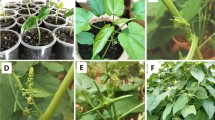Summary
We examined the extent of ovule abortion and the within-fruit pattern of abortion inCassia fasciculata, an annual legume, and tested the hypothesis that abortion can result from competition for limited maternal resources among developing fruits and seeds. In a natural population at Mayview, IL, 53.4% of ovules in mature fruits matured as seeds; 43.4% showed some development but aborted, and 3.1% showed no development over virgin ovules. In a greenhouse experiment in which treatments were applied after most fruits were initiated, nutrient addition and partial root removel had no effect on abortion, but drought reduced the proportion of ovules maturing to 75% of the control mean. A fruit thinning experiment was conducted in which the number of fruits initiated on certain plants was limited. Control plants had more ovule abortion than fruit-thinned plants, suggesting that abortion resulted from competition for limited maternal resources. A “position effect” was observed in both field and greenhouse populations; ovules toward the fruit base (pedicellar end) had higher frequencies of abortion than those at the distal end. Thus, ovule abortion, like fruit abortion in this species, is non-random. Indivisuals regulate fecundity at both the whole fruit and individual seed levels.
Similar content being viewed by others
References
Adams MW (1967) Bases of yield component compensation in crop plants with special reference to the field beanPhaseolus vulgaris. Crop Sci 7:505–510
Barnes DK, Cleveland RW (1963) Genetic evidence for non-random fertilization in alfalfa as influenced by differential pollen tube growth. Crop Sci 3:295–297
Bawa KS and Webb CJ (1984) Flower, fruit and seed abortion in tropical forest trees: implications for the evolution of paternal and maternal reproductive patterns. Amer J Bot 71:736–751
Bertin RI (1982) Paternity and fruit production in trumpet creeper (Campsis radicans). Amer Natur 119:694–709
Bierzychudek P (1981) Pollination limitation of plant reproductive effort. Amer Natur 117:838–840
Bookman SS (1984) Evidence for selective fruit production inAsclepias. Evolution 38:72–86
Brink RA, Cooper DC (1937) Somatoplastic sterility inMedicago sativa. Science 90:545–546
Casper BB (1983) The effeciency of pollen transfer and rates of embryo initiation inCryptantha (Boraginaceae). Oecologia (Berlin) 59:262–268
Casper BB (1984) On the evolution of embryo abortion in the herbaceous perennialCryptantha flava. Evolution 38:1337–1349
Casper BB, Wiens D (1981) Fixed rates of random ovule abortion inCryptantha flava (Boraginaceae) and its possible relation to seed dispersal. Ecology 62:866–869
Cooper DC, Brink RA (1940) Partial self-incompatibility and the collapse of fertile ovules as factors affecting seed formation. J Agr Res 60:453–472
Cooper DC, Brink RA, Albrecht HR (1937) Embryo mortality in relation to seed formation in alfalfa (Medicago sativa). Amer J Bot 24:203–213
Coulter MC (1979) Seed abortion inAnagallis arvensis on Southwest Farallon Island, California. Madrono 26:101–102
Crowe LK (1971) The polygenic control of outbreeding inBorago officinalis. Heredity 27:111–118
Horovitz A, Meiri L, Beiles A (1976) Effects of ovule positions in Fabaceous flowers on seed set and outcrossing rates. Bot Gaz 137:250–254
Janzen DH (1971) Seed predation by animals. Annu Rev Ecol Syst 2:465–492
Jones DF (1928) Selective fertilization. The University of Chicago Press, Chicago, Illinois
Kambal AE (1969) Flower drop and fruit set in field beans,Vicia faba L. J Agr Soc Camb 72:131–138
Kress WJ (1981) Sibling competition and evolution of pollen unit, ovule number, and pollen vector in angiosperms. Syst Bot 6:101–112
Lee TD (1984) Patterns of fruit maturation: a gametophyte competition hypothesis. Amer Natur 123:427–432
Lee TD, Bazzaz FA (1982a) Regulation of fruit and seed production in an annual legume,Cassia fasciculata. Ecology 63:1363–1373
Lee TD, Bazzaz FA (1982b) Regulation of fruit maturation pattern in an annual legume,Cassia fasciculata. Ecology 63:1374–1388
Levin DA (1984) Inbreeding depression and proximity-dependent crossing success inPhlox drummondii. Evolution 38:116–127
Linck AJ (1961) The morphological development of the fruit ofPisum sativum, var.alaska. Phytomorphology 11:79–84
Lloyd DG (1980) Sexual strategies in plants. I. An hypothesis on serial adjustment of maternal investment during one reproductive session. New Phytol 86:69–79
Lovett Doust J, Eaton GW (1982) Demographic aspects of flower and fruit production in bean plants,Phaseolus vulgaris L. Amer J Bot 69:1156–1164
McAlister DF, Krober OA (1958) Response of soybeans to leaf and pod removal. Agron J 50:674–679
Mogensen HL (1975) Ovule abortion inQuercus (Fagaceae). Amer J Bot 62:160–165
Mulcahy DL (1979) The rise of the angiosperms: a genecological factor. Science 206:20–23
Mulcahy DL, Mulcahy GB (1983) Gametophytic self-incompatility re-examined. Science 220:1247–1251
Nakamura RR (1983) Reproductive capacity and kinship inPhaseolus vulgaris L. Dissertation, Yale University, New Haven, CT
Robins JS, Domingo CE (1956) Moisture deficits in relation to the growth and development of dry beans. Agron J 48:67–70
Silander JA (1978) Density-dependent control of reproductive success inCassia biflora. Biotropica 10:292–296
Snow AA (1982) Pollination intensity and potential seed set inPassiflora vitifolia. Oecologia (Berlin) 55:231–237
Stephenson AG (1981) Flower and fruit abortion: proximate causes and ultimate functions. Annu Rev Ecol Syst 12:253–279
Tayo TO (1983) Effect of sink size on the pod and seed characteristics of soya beans (Glycine max (L.) Merr.) in the lowland tropics. J Agric Sci Camb 100:285–292
Watson MA, Casper BB (1984) Morphogenetic constraints on patterns of carbon distribution in plants. Annu Rev Ecol Syst 15:233–258
Westoby M, Rice B (1982) Evolution of the seed plants and inclusive fitness of plant tissues. Evolution 36:713–724
Wiens D (1984) Ovule survivorship, brood size, life history, breeding systems, and reproductive success in plants. Oecologia (Berlin) 64:47–53
Williams DDF (1962) Influence of soil moisture level on flower abscission, ovule abortion, and seed development in the snap bean (Phaseolus vulgaris L.). Diss Abstr 22:2933
Willson MF, Burley N (1983) Mate choice in plants: tactics, mechanisms, and consequences. Princeton Univ. Press, Princeton, N.J.
Wyatt R (1981) Components of reproductive output in five tropical legumes. Bull Torrey Bot Club 108:67–75
Author information
Authors and Affiliations
Additional information
Scientific contribution no. 1357 from the New Hampshire Agricultural Experiment Station
Rights and permissions
About this article
Cite this article
Lee, T.D., Bazzaz, F.A. Maternal regulation of fecundity: non-random ovule abortion inCassia fasciculata Michx.. Oecologia 68, 459–465 (1986). https://doi.org/10.1007/BF01036755
Received:
Issue Date:
DOI: https://doi.org/10.1007/BF01036755




